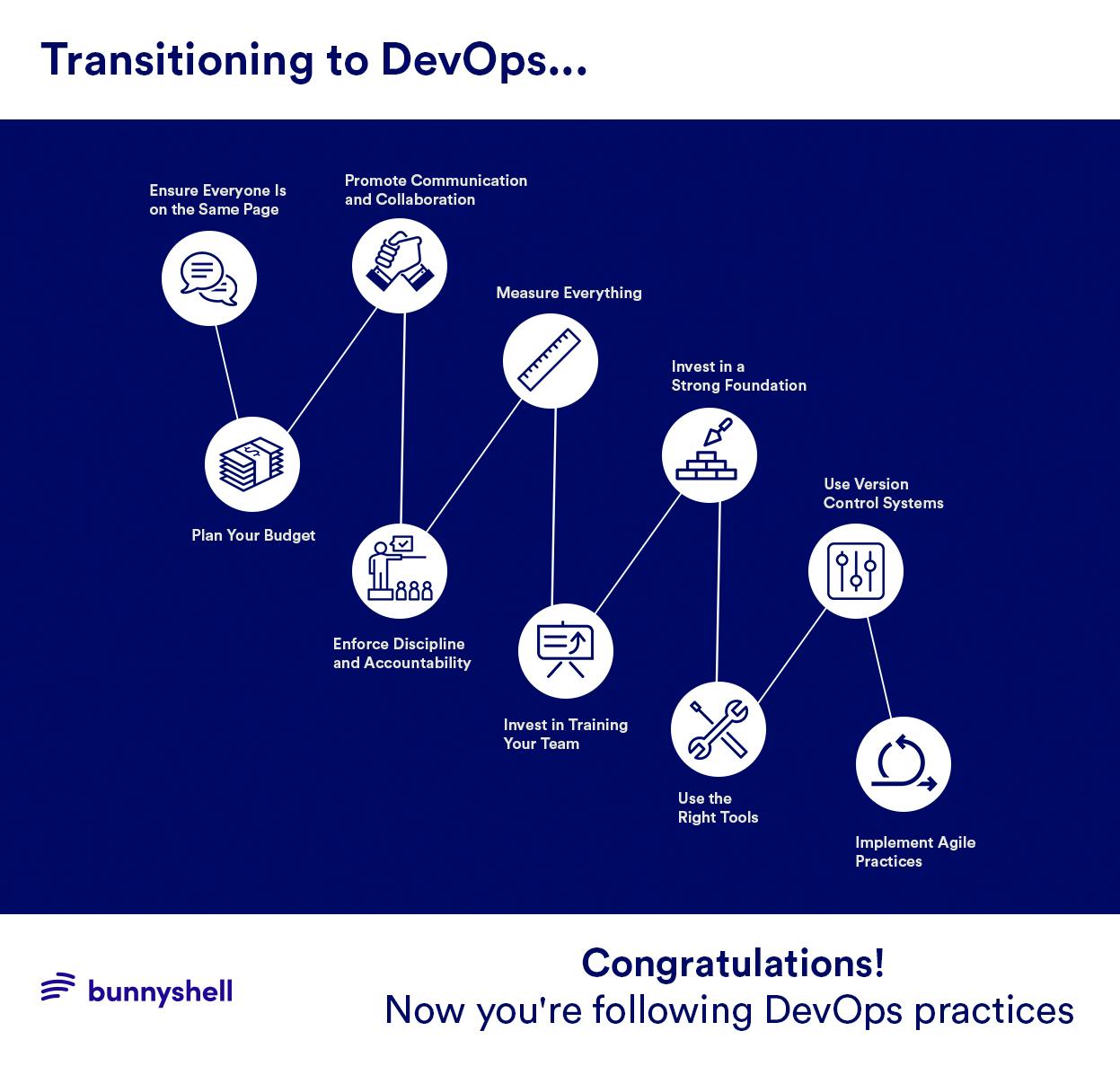In our previous article, ‘What is DevOps?’ we were mentioning that DevOps is not just a bunch of tools, but rather a mix of cultural, development, and operational changes. Naturally, changing your company culture is not something you can do overnight; actions and decisions should be carefully thought out.
However, many organizations try to cut corners and get on board this ‘trend’ as fast as possible without a clear vision or strategy, which results in them not actually properly adopting or implementing DevOps.
According to Gartner’s report, “New Insights into Success with Agile in Digital Transformation,” organizations must be prepared for a commitment of at least 3 years to ensure success when moving to a more Agile development process. Teams with less than a year of experience with a new development process show a success rate of only 34%, while for those with more than 3 years of experience, the percentage skyrockets to 81.
So, why would transitioning to DevOps be any easier or faster?
Now, while adopting a DevOps culture is challenging, it’s definitely not impossible if you follow the right steps. So, in this article, we’ll show you how to transition to DevOps as smoothly as possible.
Preparation Steps for the Transition to DevOps

Implementing Continuous Integration (CI), Continuous Delivery/Deployment (CD), and Continuous Testing (CT) ensures releases are more reliable and error-free, which leads to higher productivity, efficiency, and customer satisfaction.
But before you jump straight in, there are a few behavioral and technical preparations you should make.
Ensure Everyone Is on the Same Page
As this is a cultural shift that will affect everyone in your organization, you need to make sure everyone is on board. Start by educating them on what DevOps is, and highlight why it’s important for your organization to make this change. If they don’t understand the benefits or are unwilling to cooperate, it will be challenging for you to move forward.
Plan Your Budget
Another significant factor you should consider before transitioning to DevOps is creating a rough estimate of the expenses your organization will bear while transitioning and integrating. Not having a clear plan to follow leads to wastage of money and reduction in productivity.
Promote Communication and Collaboration
Communication and collaboration are the core of DevOps, which aims to overcome the ‘silo mentality’ that most companies are guilty of. One thing you should keep in mind, though, is that DevOps does not stop at development and operations. Instead, all stakeholders – security people, network admins, QA engineers, product managers, business folks, etc. – should work together towards common goals and objectives.
So how do you do that? You adopt Agile development practices. When everyone knows their role in the team, as well as their teammates’, things run more smoothly. They understand why they are doing what they’re doing and who they should approach for help and feedback. They also have an overview of where the project is heading and the steps that will lead them there.
From a technical perspective, you should consider using a project management tool like Kanban to track progress.
Enforce Discipline and Accountability
Building on the previous point, in order to transition to a DevOps culture, you need to enforce discipline and accountability. Developers, for example, should learn to become responsible for their code, making sure it’s good and secure, and not rely on QA or Security Engineers to tell them what to fix.
A few things that can help your organization foster a sense of responsibility are:
- spike programming
- test-driven development
- unit tests
- commented code.
As in the DevOps model, engineers work through the entire application lifecycle, from development and testing to implementation and operations, they also need to develop a diverse set of skills that aren’t limited to a single role. The most common example here is developers who know how to deploy an application – even when it’s not in their job description, it still helps the team be more Agile.
Measure Everything
You cannot determine whether your transition to DevOps is progressing or not if you don’t know where you’ve started from. So it’s imperative to measure the current metrics of different stages of the software development life cycle (for example, time taken to develop, test, etc.) and compare them with the results after the implementation of DevOps practices.
By starting with testing the velocity, you’ll be able to assess whether your DevOps team delivers faster and is able to adapt to change. Additionally, you can also use customer metrics to track progress, but make sure they are specific to avoid confusion and frustration on both parts.
Analyzing the team’s morale will let you know whether they’re excited and motivated when a new implementation is introduced. When DevOps Engineers talk to other teams about how they’ve managed to solve a problem using a new mentality or technology, this will make the others curious and more eager to shift to DevOps as well.
Invest in Training Your Team
As we’ve mentioned above, DevOps is about developing a new skill set. And with that in mind, you should view training and investing in your team as a long-term investment in your company that will help you change your approach to the development cycle.
A common objection to taking an engineer out of production to train them is that this reduces the employee hours spent on a specific project, making an organization less profitable. But actually, investing in your team’s education can lead to faster completion times in the future (not to mention the superior quality of their work), so more profitable projects long-term.
Invest in a Strong Foundation
You need a solid foundation to build on top of, and that means investing in the right technologies and tools. If possible, think everything cloud-native from day 1, or consider migrating to the cloud sooner rather than later. With the right infrastructure, you can build just about anything.
As part of this cloud-first style of operating, you should also carefully consider your business partners – cloud providers, hosting providers, managed services providers, etc. What you should be looking for is a partner that can help you maximize deployment flexibility, security, and overall performance.
Use the Right Tools
Now, DevOps may be about the mindset and skills, not the tools, but they’re still important. Transitioning to DevOps works better when teams are familiar / have previous experience working with tools such as Git, Docker, Kubernetes, Hadoop, or Cassandra.
Another important thing to keep in mind here is that the tools you choose are compatible with each other and enhance the working environment. Ideally, they should all come from the same seller as this ensures they are more integrated with each other than tools from different vendors.
Use Version Control Systems
The ability to save work, rollback changes, and access archived code is crucial as you never know when a feature or code snippet you’ve written for a past project might come in handy. Shared repositories also help your team collaborate more efficiently.
Implement Agile Practices
In a previous article, we mentioned that, when transitioning to DevOps,organizations shouldn’t abandon their Agile workflow. Instead,DevOps and Agileshould be used together to achieve:
- more reliable releases
- greater efficiency due to automation
- increased productivity
- consistent development.
Now You’re Ready to Transition to DevOps
Once you’ve made the necessary preparations, you can start your actual transition to DevOps.
Start Small
Instead of changing all departments at once, make small changes and scale up gradually over time. It’s easier (and safer!) to start with a small team, observe their achievement or improvement, and then implement best practices to another team until your whole organization transitions to DevOps.
On the same note, don’t try to automate all processes at once – the transition from the traditional approach to DevOps doesn’t happen overnight. If possible, you should also consider hiring a professional who is experienced in the field of automation that can guide your team through the process.
Enhance Security
Strengthening security is a fundamental step towards complete DevOps transformation. And although it should be everyone’s responsibility and priority, it’s still recommended to hire skilled security teams for strict monitoring of the configuration, infrastructure, and integrity.
Measuring DevOps Success
Many companies fail to measure DevOps effectively. While there are many factors to consider, there are 3 that stand out the most: cost, modernization, and performance.
Still, you should measure success depending on what you try to achieve. Maybe you’re not implementing DevOps because of the financial aspect; instead, you’re more interested in transitioning to more modern infrastructure. Or maybe you want to improve your app’s performance over time – these are all valid goals to use when measuring whether your transition to DevOps was successful.
How Bunnyshell Can Help
Organizations that have implemented DevOps say they have achieved significant improvements in infrastructure stability, app development speed, and security. However, this is only true when the implementation is right.
We know transitioning to DevOps is a challenging task, so we’ve built a tool that can help organizations make the process easier. Our customers get MAJOR benefits by using Bunnyshell – we’re pioneers when it comes to DevOps automation, and we’re proud to say that we managed to bring our platform to a stage where there’s ZERO DevOps experience required for teams to build, deploy, and scale modern apps.
If you’re interested in learning more, let’s get in touch.
